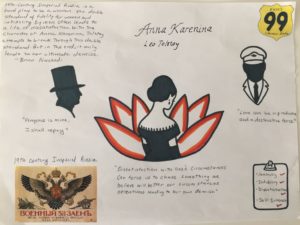19th-Century Imperial Russia is a Hard Place to be a Woman
Hailed as a literary masterpiece, Anna Karenina for me was a surprisingly simple piece of writing that captures the depths of human emotion and nature. From the thrills of infidelity and falling in love with a new partner, to the deep jealousy and dissatisfaction that often times creeps into one’s relationship, Tolstoy manages to write openly about the base human emotions we often try to shut away. Through Anna Karenina Tolstoy focuses on the point that we are inherently self-interested by nature, and when in a relationship with another, we are in a constant struggle to put others first. As Stephan Arkadyevitch’s behavior shows, typically our baser level instincts and nature’s win out. But Tolstoy reminds us in the characters of Levin and Kitty, that there is hope for those who rise above this inherent self-first nature.
Throughout this novel the underlying theme of dissatisfaction with one’s circumstances, and Tolstoy captures this perfectly with the character of Anna herself. In her ultimate demise, Tolstoy seems to say that chasing perfection or bettering one’s circumstances can often lead to your demise.
Looking for perfection in your circumstances (i.e. spouse, job, etc.) can oftentimes lead to further dissatisfaction, and rather “one must forget oneself and love others, and one will be happy, and noble.” Put another way, selflessness (putting others first) over selfishness is the only way towards long-term satisfaction in one’s relationship.
In closing, the mistake we often make as humans is to think that our happiness will come through the realization of our baser human desires. But in Tolstoy’s Anna Karenina, we see that the true path to happiness, especially when in a relationship is pure unadulterated selflessness. We must love our spouses and partners as the whole person just as they are, and not as we would like them to be.
Big Themes in this Book
Love
The pursuit of love can be both a positive and destructive force in ones life. For Anna, she pursues love outside her marriage which leads to the abandonment of her son and her ultimate suicide. Through the ultimate demise of Anna, Tolstoy reminds us that the cult of love can cut deeply and when pursued in the wrong fashion, can kill. Anna Karenina isn’t a traditional love story with that mushy gushy ending.
Marriage is a Burden Necessary to Hold Society Together
To a majority of the characters in this book, marriage is a burden and hindrance to achieving the life especially the men. Throughout the book, the male characters primary interests lie outside the home whereas the female characters primary interests lie within the home. But Tolstoy stresses that regardless of its potential faults, marriage is the glue that holds society together. What’s very interesting about this theme is the fact that in the late 2000s, the diary of Leo Tolstoy’s wife was transcribed. It paints a marriage that seems to be based in the themes he writes within Anna Karenina.
Double Standard of Fidelity
It’s a man’s right to be unfaithful to his wife in the face of her unyielding fidelity, and throughout this book you get the sense that it’s less serious for a husband to stray than a wife since family unity depends on the woman.
It’s a man’s right to be unfaithful to his wife in the face of her unyielding fidelity, and throughout this book you get the sense that it’s less serious for a husband to stray than a wife since family unity depends on the woman.

